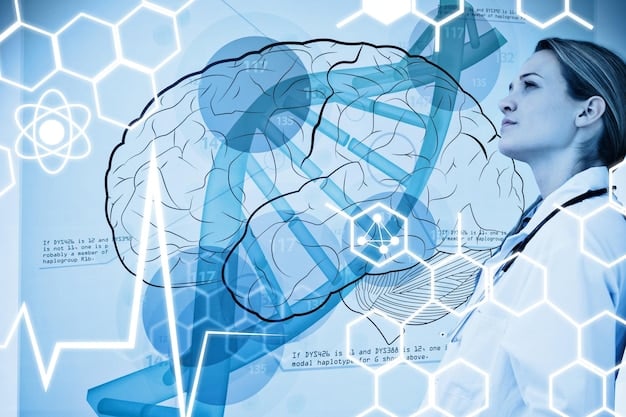Ethical AI in US Healthcare: Navigating Diagnostics Dilemmas

The ethical implications of AI-driven healthcare diagnostics in the US encompass concerns about algorithmic bias, data privacy, patient autonomy, and the potential for unequal access to advanced medical technologies, requiring careful consideration and robust regulatory frameworks.
The rapid advancement of artificial intelligence (AI) in healthcare promises transformative improvements in diagnostics, offering the potential for earlier detection, more accurate diagnoses, and personalized treatment plans. However, the integration of AI in healthcare raises significant ethical questions, particularly concerning what are the ethical implications of AI-driven healthcare diagnostics in the US?. These implications span a wide range of issues, demanding careful consideration to ensure that AI benefits all members of society while upholding fundamental ethical principles.
Understanding AI-Driven Healthcare Diagnostics
AI-driven healthcare diagnostics refers to the use of artificial intelligence algorithms to analyze medical data, such as images, lab results, and patient records, to assist in the diagnosis of diseases and health conditions. AI algorithms are trained on vast datasets to recognize patterns and anomalies that may be indicative of specific illnesses, providing insights that can aid clinicians in making more informed decisions.
This technology offers numerous potential benefits, including increased efficiency, improved accuracy, and the ability to detect diseases at earlier stages. Yet, alongside these advantages, there are significant ethical considerations that must be addressed to ensure responsible and equitable deployment of AI in healthcare.
Benefits of AI in Diagnostics
AI algorithms can process large volumes of data more quickly and efficiently than human clinicians, potentially reducing diagnostic delays and improving patient outcomes.
AI can identify subtle patterns and anomalies that may be missed by the human eye, leading to more accurate diagnoses and personalized treatment plans.
Challenges of AI in Diagnostics
AI algorithms are only as good as the data they are trained on, and if the training data is biased, the AI system may perpetuate or even exacerbate existing health disparities.
There is a lack of transparency in how AI algorithms arrive at their conclusions, making it difficult to understand and trust their recommendations.
- Improved Efficiency: AI systems can analyze medical images and data faster than human experts.
- Enhanced Accuracy: AI can detect subtle patterns and correlations in data that might be missed by humans.
- Early Detection: AI can help identify diseases at an earlier stage, leading to better treatment outcomes.
- Personalized Medicine: AI can tailor treatment plans based on individual patient characteristics.
In conclusion, AI-driven healthcare diagnostics holds immense promise for revolutionizing healthcare, improving efficiency, and enhancing accuracy. However, realizing these benefits requires a careful and deliberate approach that addresses the ethical challenges. By focusing on fairness, transparency, and accountability, we can ensure that AI serves as a force for good in healthcare, promoting health equity and improving patient outcomes for all.

Algorithmic Bias and Fairness
One of the most pressing ethical concerns surrounding AI-driven healthcare diagnostics is the potential for algorithmic bias. AI algorithms are trained on data, and if that data reflects existing biases, the AI system will likely perpetuate or even amplify those biases. This can lead to inaccurate diagnoses or inappropriate treatment recommendations for certain demographic groups.
Algorithmic bias can arise from several sources, including biased training data, biased algorithm design, and biased interpretation of results. It is crucial to address these sources of bias to ensure that AI systems are fair and equitable for all patients. This requires diverse datasets, careful algorithm design, and ongoing monitoring to detect and mitigate bias.
Sources of Algorithmic Bias
Historical biases present in the training data can be reflected in the AI system’s outputs, leading to unfair or discriminatory outcomes.
Biases in the design of the algorithm, such as the choice of features or the weighting of different factors, can also contribute to algorithmic bias.
Mitigating Algorithmic Bias
Collecting and using diverse datasets that accurately reflect the populations being served can help reduce bias in AI systems.
Ensuring transparency in algorithm design and allowing for external audits can help identify and correct biases.
- Data Diversity: Ensure training datasets are representative of all patient populations.
- Transparency: Promote transparency in algorithm design and decision-making processes.
- Auditing: Conduct regular audits to detect and mitigate bias in AI systems.
- Interdisciplinary Collaboration: Encourage collaboration between data scientists, clinicians, and ethicists.
In summary, to counter algorithmic bias, healthcare institutions and AI developers need to prioritize data diversity, ensure transparency in algorithms, conduct regular audits, and foster cross-disciplinary collaborations. By addressing these factors, we can create AI systems that are fair, reliable, and beneficial to all patients. Failing to do so risks perpetuating existing health disparities and undermining the potential of AI to improve healthcare outcomes.
Data Privacy and Security
Data privacy and security are paramount when dealing with sensitive medical information. AI-driven healthcare diagnostics relies on access to vast amounts of patient data, including medical records, genomic information, and imaging data. Protecting this data from unauthorized access, breaches, and misuse is essential to maintaining patient trust and upholding ethical standards.
Robust data governance frameworks, encryption technologies, and strict access controls are necessary to safeguard patient data. Compliance with regulations such as the Health Insurance Portability and Accountability Act (HIPAA) is crucial, and organizations must implement comprehensive cybersecurity measures to prevent data breaches and protect patient privacy.
Data Governance Frameworks
Establishing clear policies and procedures for data collection, storage, and use can help ensure that patient data is handled responsibly.
Implementing strong encryption technologies can protect patient data from unauthorized access.
Compliance with Regulations
Adhering to HIPAA regulations and other relevant data privacy laws is essential for maintaining patient trust and avoiding legal penalties.
Regularly updating cybersecurity measures can help protect against data breaches and unauthorized access.

- Data Encryption: Use strong encryption methods to protect patient data at rest and in transit.
- Access Controls: Implement strict access controls to limit who can access patient data.
- Data Minimization: Collect only the data that is necessary for the specific diagnostic task.
- Regular Audits: Conduct regular security audits to identify and address vulnerabilities.
In conclusion, ensuring the data privacy and security of patient information is critical for building trust in AI-driven healthcare diagnostics. Robust data governance frameworks, strict compliance with regulations, and proactive cybersecurity measures are all necessary to safeguard patient data. By prioritizing data protection, healthcare organizations can harness the power of AI while upholding their ethical obligations to patients.
Patient Autonomy and Informed Consent
Patient autonomy, the right of patients to make informed decisions about their healthcare, is a fundamental ethical principle. The use of AI in healthcare diagnostics raises questions about how to ensure that patients are adequately informed about the role of AI in their care and that they have the opportunity to consent to its use.
Transparent communication about the use of AI, its potential benefits and risks, and the implications for patient care is essential. Patients should be provided with clear and understandable information, allowing them to make informed decisions about whether to participate in AI-driven diagnostic processes. Respecting patient autonomy means empowering patients to actively engage in their healthcare decisions.
Transparent Communication
Providing clear and understandable information about the use of AI in diagnostics can help patients make informed decisions.
Discussing the potential benefits and risks of AI-driven diagnostics can help patients understand the implications for their care.
Informed Consent
Obtaining informed consent from patients before using AI in their care is essential for respecting their autonomy.
Ensuring that patients have the opportunity to ask questions and express concerns can help promote trust.
- Clear Explanations: Provide clear explanations about how AI is used in the diagnostic process.
- Risk Disclosure: Disclose potential risks and limitations of AI-driven diagnostics.
- Patient Choice: Allow patients to opt out of AI-driven diagnostic processes.
- Shared Decision-Making: Encourage shared decision-making between clinicians and patients.
In summary, to uphold patient autonomy in the age of AI-driven diagnostics, clear and transparent communication, along with the emphasis on informed consent, is quintessential. By empowering patients with information and ensuring they have the autonomy to make their own healthcare decisions, clinicians can build trust and foster a collaborative relationship that respects the rights and values of each individual.
Responsibility and Accountability
Assigning responsibility and accountability in AI-driven healthcare diagnostics is complex. When an AI system makes an incorrect diagnosis or recommends an inappropriate treatment, it can be difficult to determine who is responsible. Is it the AI developer, the clinician who used the system, or the healthcare organization that deployed it?
Establishing clear lines of responsibility and accountability is crucial for ensuring that AI systems are used safely and ethically. This requires a multidisciplinary approach involving AI developers, clinicians, healthcare administrators, and regulators. Clear policies and procedures should be in place to address errors and adverse events, and mechanisms for redress should be available to patients who are harmed by AI-driven diagnostics.
Defining Roles and Responsibilities
Clearly defining the roles and responsibilities of AI developers, clinicians, and healthcare organizations can help ensure accountability.
Establishing clear policies and procedures for addressing errors and adverse events can help protect patients.
Mechanisms for Redress
Providing mechanisms for patients to seek redress when they are harmed by AI-driven diagnostics is essential for fairness.
Developing clear guidelines for investigating and resolving complaints can help promote trust.
- Clear Guidelines: Develop clear guidelines for the use of AI in diagnostics.
- Training Programs: Provide training programs for clinicians on the use of AI systems.
- Incident Reporting: Establish incident reporting systems to track errors and adverse events.
- Legal Frameworks: Develop legal frameworks to address liability and accountability.
In conclusion, as AI becomes more integrated into healthcare diagnostics, responsibility and accountability must be key considerations. By establishing clear guidelines, providing comprehensive training, implementing incident reporting systems, and developing legal frameworks, the healthcare industry can ensure that AI technologies are used responsibly and ethically. This proactive approach is crucial for protecting patients and fostering trust in AI-driven medical interventions.
Access and Equity
Ensuring equitable access to AI-driven healthcare diagnostics is crucial for addressing health disparities and promoting health equity. AI has the potential to exacerbate existing inequalities if it is not deployed in a way that benefits all members of society. Factors such as socioeconomic status, geographic location, and insurance coverage can influence access to advanced medical technologies, including AI-driven diagnostics.
Efforts to promote equitable access should focus on reducing barriers to care, expanding access to underserved populations, and tailoring AI systems to the specific needs of diverse communities. Policy interventions, public funding, and community engagement can play a vital role in ensuring that AI benefits all individuals, regardless of their background or circumstances.
Reducing Barriers to Care
Addressing socioeconomic barriers, geographic barriers, and insurance barriers can help ensure equitable access to AI-driven diagnostics.
Expanding access to underserved populations through community-based programs can help reduce health disparities.
Tailoring AI Systems
Developing AI systems that are tailored to the specific needs of diverse communities can help ensure that they are effective and appropriate.
Engaging with community members to understand their needs and preferences can help promote trust and acceptance.
- Affordable Access: Ensure that AI-driven diagnostics are affordable and accessible to all.
- Telehealth Solutions: Leverage telehealth solutions to expand access to remote areas.
- Community Engagement: Engage with community members to understand their needs and preferences.
- Policy Interventions: Implement policies to promote health equity and reduce disparities.
In conclusion, the equitable distribution of AI-driven diagnostics necessitates proactive measures to lower barriers, enhance access in underserved regions, and customize AI systems to suit various community requirements. Policy interventions, public funding, and community engagement are critical to ensuring AI’s benefits extend to all individuals, regardless of their socioeconomic status or background. By promoting health equity, AI can improve outcomes for everyone.
| Key Point | Brief Description |
|---|---|
| 🤖 Algorithmic Bias | AI’s potential to perpetuate bias if trained on skewed data. |
| 🔒 Data Privacy | Secure handling of sensitive medical data is crucial. |
| ✅ Patient Autonomy | Patients must be informed about AI involvement and consent. |
| ⚖️ Equitable Access | AI diagnostics must be accessible to all, regardless of background. |
FAQ
▼
AI-driven healthcare diagnostics uses artificial intelligence algorithms to analyze medical data, such as images and patient records, to assist in the diagnosis of diseases and health conditions, enhancing accuracy.
▼
Algorithmic bias can lead to inaccurate diagnoses or inappropriate treatment recommendations for certain demographic groups if the AI is trained on biased data, perpetuating health disparities.
▼
Protecting patient data from unauthorized access and misuse is essential for maintaining trust and upholding ethical standards, particularly when AI systems rely on vast amounts of sensitive information.
▼
Patient autonomy refers to the right of patients to be fully informed about the use of AI in their care and to make informed decisions about whether to consent to AI-driven diagnostic processes.
▼
Equitable access can be ensured by reducing barriers to care, expanding access to underserved populations, and tailoring AI systems to the specific needs of diverse communities through policy and community engagement.
Conclusion
In conclusion, the integration of AI in healthcare diagnostics offers transformative potential, but requires careful attention to ethical considerations. By addressing issues such as algorithmic bias, data privacy, patient autonomy, and equitable access, we can ensure that AI benefits all members of society. Establishing clear guidelines, promoting transparency, and fostering collaboration between AI developers, clinicians, and ethicists are essential for realizing the full potential of AI while upholding ethical standards. The goal is to harness AI in a way that enhances patient care, promotes health equity, and builds trust in healthcare systems across the United States.





